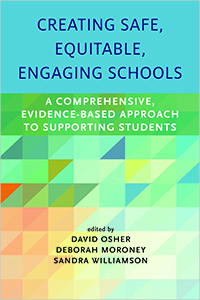What We’ve Learned About Creating Safe, Equitable, and Engaging Schools

Every year, the Learning First Alliance convenes Public Schools Week to recognize the importance of public schools. The theme of Public Schools Week 2022 is “Creating Safe, Equitable and Engaging Public Schools,” which directly aligns to the AIR-authored volume, Creating Safe, Equitable, Engaging Schools. In this series, contributors to the volume provide fresh insights on what safe, equitable, and engaging means in our current context.
Successful teaching and learning have always been hard, but right now, for educators, students, and their families, these activities feel almost impossible. The importance of safety, engagement, and equity for all students, educators, and families has never been more palpable. Addressing the social, emotional, and academic needs of our children, educators, and communities seems almost too daunting. It is certainly too big and too important to do alone, and it is imperative that schools and families work together. But how should we begin this work? The answer to that question is grounded in fundamentals that we knew well before the pandemic and our current social and political crises.
Six Principles That Are Integral to Learning
Four years ago, we collaborated on the introduction to a book, Creating Safe, Equitable, Engaging Schools. At the time, no one had heard of COVID-19 or imagined the significant impact it would have on education. Few people knew the names of George Floyd, Philando Castile, and Ahmaud Arbery, whose killings have become a flashpoint for racial reckoning in our society. And the Jan. 6 riot at the U.S. Capitol seemed almost unimaginable.
We did, however, know then about the increasingly compelling research, evidence, and practical experience highlighting the centrality of physical and emotional safety, the importance of academic and social engagement, and the need for robust equity for students to learn. Our introduction shared six practical, science-based principles that not only ground the book, but also speak to our current crises.
These six principles are integral to learning. When we are attentive to them, they can enhance learning. However, when we ignore them, they can undermine learning. These principles can and should be realized in every interaction that takes place between and among learners and educators. Implementation must be systematic, collaborative, and embrace and be informed by the voices of culturally and linguistically diverse students, families, and school staff. Let’s briefly explore these principles:
1. Relationships drive learning, including the relationships students see adults modeling. Working together, starting by fostering trust and collaboration, is the only way to address our problems. We must listen as educators raise ideas for improving schools, such as how class size affects relationship-building and sustainable pathways to diversifying teaching. Problems cannot be resolved when we are suspicious of each other and do not appreciate each other’s experience and knowledge.
2. Stress undermines learning, and the community must work to address the stress our students and schools experience, eliminate it wherever possible, and provide resources to address it where it can’t be eliminated.
3. Social, emotional, and academic skills are inextricably linked and can be developed and learned under supportive and culturally responsive conditions. This has always been the case, but it is particularly pronounced now, when students must develop metacognitive skills to help them manage their learning, curate information, and adapt to a rapidly changing world and workplace.
4. Conditions for learning and teaching matter, and these require addressing identity, safety, and the impacts of institutionalized prejudice and privilege. Physical, emotional, identity, and intellectual safety affect learning and teaching. Connectedness, support, and the feeling that you belong and have agency, both as individuals and as a member of a group or community, also affect learning and teaching.
5. The impacts of stress and adversity can and must be addressed, and resilience can be supported. We need to provide people with the tools and social resources to address the causes of trauma, stress, and adversity. Resilience can be supported with relationships, professional staff, and meaningful family engagement.
6. Culture, identity, emotions, and subjective perceptions affect learning. Concepts such as “no excuses” and “zero tolerance,” narrow definitions of achievement, and a singular focus on high stakes standardized tests tend to be prioritized over a comprehensive, research-based approach that centers safe, equitable, and engaging schools. We cannot get trapped into laws or policies that prioritize anonymous tip lines, surveillance, narrowed curriculum, a pause on state standards, banning books, or the marginalization of any student, including those who are transgender. Research shows that building relationships, eliminating stress, and creating supportive conditions for teaching and learning make a real difference for our students. We all have a responsibility to recognize that academic needs, social and emotional needs, and safe and welcoming environments are interdependent on one another.
Creating Meaningful, Robust Collaboration
Family-educator collaboration is necessary but not sufficient to address the pressing needs of education. It also requires collaboration with community organizations and students and empowering them to actively participate in shaping their schools and their learning.
It’s always been important to involve students in shaping their education and listen to their needs. During this pandemic, our students have grown in their leadership and assertiveness, in spite of all they have experienced. They are no longer waiting for the adults in their lives to involve them or listen to them. This new year found, for example, students from California; Chicago; Denver; Montgomery County, Maryland; New York City; Oakland, California; Saint Paul, Minnesota; and others walking out of school as a way to voice their own demands for safety and learning. Students are telling us they expect to be heard. We would be foolish not to listen. We need their insights, and we should value, not just tolerate, their involvement in designing safe and welcoming teaching and learning conditions.
We all have a responsibility to recognize that academic needs, social and emotional needs, and safe and welcoming environments are interdependent on one another.
Both of us have made it a point to create opportunities that center student voices in to achieve these goals. David’s research has asked students to describe what is necessary for both learning and creating a safe and supportive environment. This work has led to findings that students prefer classrooms where teachers call them by their names, avoid what embarrasses them, have high expectations and challenge them, and strongly support them.
In every teaching and leading opportunity, Mary Cathryn, a former educator and former Minnesota Commissioner of Education, has asked students directly, “What conditions need to be in place so that I can both successfully meet your academic needs and also be present and mindful of your social and emotional needs?” She has shaped teacher contract language based on student answers. This question should be asked frequently until we have successfully addressed long-standing socioeconomic pressures, racial inequalities, and academic disparities that have only grown since the pandemic began.
Collaboration, Partnership, and Re-Examination of Our Approaches Are Essential to Deepening Learning
Changing how schools work is not impossible, but it will require us to rethink our priorities. There is powerful guidance in the syntheses of the science of learning and development, along with evidence from effective equitable practices, for what to do for all students, but especially the most vulnerable. This is an unprecedented time of federal commitment, thanks to legislation such as the American Recovery Act, to fund the incubation of these ideas, collect the results, and deliver them to state and federal lawmakers with expectations that they continue. A community of allies, who desperately want our students to succeed, are ready to do what works.
In our shared urgency to support our students and strengthen their learning, we must take the time to listen to each other’s needs and to meaningfully collaborate. It is a mistake to think that accelerating learning at the expense of addressing adult and student well-being and engagement will result in deepened learning. We will go farther together if we listen and partner with students and their families and their educators to reset our approach to teaching and learning so that we are truly inclusive in meeting the academic, social, and emotional needs of students in safe and welcoming environments for good. We must stay at the table, together, to create the safe, equitable, and engaging schools our students deserve.
David Osher is a Vice President and Institute Fellow at the American Institutes for Research and is an international expert in many areas of education, including social and emotional learning and the science of learning and development. Mary Cathryn Ricker is the Executive Director of the Albert Shanker Institute, a National Board Certified teacher, and the former Minnesota Commissioner of Education.

